|
Trumpeter's 1/32 scale
Messerschmitt Me 262A-1a
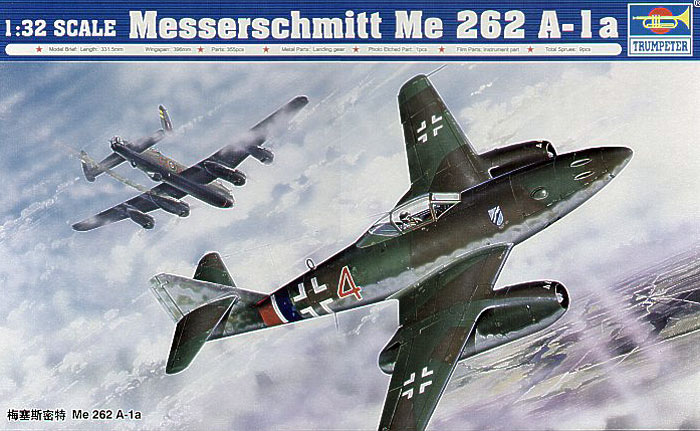
S
u m m a r y
|
| Catalogue Number: |
02223 |
| Scale: |
1/32 |
| Contents and Media: |
355 parts in light grey and clear
injection molded plastic; four rubber
tyres; four white metal cast undercarriage legs; 14 photo-etched parts;
acetate film for instruments; markings for two
aircraft |
| Price: |
£29.95 in EU, £25.49
Export, available online from Hannants |
| Review Type: |
FirstLook |
| Advantages: |
Arguably the best Me 262 in any
scale and Trumpeter's best release to date; outline and appearance conform to
published plans and photos; high quality mouldings; high level of detail in most areas
including two full engines, gun bay, cockpit and fuselage interior;
sensible engineering resulting in a buildable kit; optional position
slats, flaps and flying surfaces (but no metal hinges - huzzah!);
very impressive, appropriate and subtle surface features including
finely recessed panel lines, fasteners and even visible screw head slot
detail!; thin, clear and accurate transparent parts; options included
two gun nose, RATO packs and different styles of nose wheel. |
| Disadvantages: |
Some extra work will be required to
display engines; rubber tyres; still has Trumpeter's typically peculiar
instrument panel configuration; questionable colour callouts, especially
for interior parts. |
| Recommendation: |
Highly Recommended. |
Reviewed by Brett Green
Trumpeter has come of age.
On seeing early production sprues of Trumpeter's 1/32 scale
Messerschmitt Me 262A-1a at the recent IPMS USA Nationals, my first impressions
were very favourable. The standard production kit arrived on my doorstep
this morning. The contents look even more impressive on closer examination.
Trumpeter's 1/32 scale Me 262A-1a comprises 355 parts in
light grey and clear injection molded plastic; four rubber tyres; four white
metal cast undercarriage legs; 14 photo-etched parts and a small acetate
film for instruments.
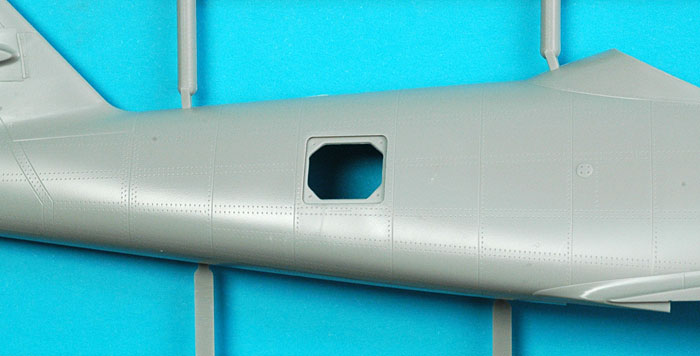
Click the thumbnails below to view
larger images:
Surface detail is the most subtle I have yet seen on any
Trumpeter kit, and in fact rivals the best on any kit produced to date. Panel lines
are very finely recessed, and carefully selected rows of rivets in places.
Subtle details such as fasteners and even slots in the heads of screws (!) are
beautifully depicted too.
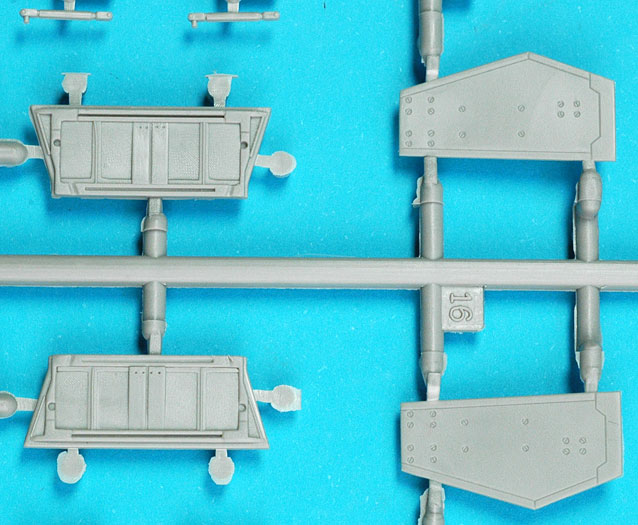
Ejector pin circles and sink marks are admirably few.
All control surfaces, including slats and flaps, are
separate. I was overjoyed to see that these are connected by fixed plastic
tabs - no wrestling with pliers and steel hinges on this model! It
will be a relatively simple matter to reposition the tabs to alter the
position of the control surfaces on the finished model.
Speaking of control surfaces, the rudder seems to be the
later style with the small navigation light near the bottom corner. Early Me
262s had a larger navigation light taking up the bottom corner of the
rudder. If you want to depict the earlier version, it would not be difficult
to cut out the small grey plastic panel and shape some clear styrene to
suit.
Clear parts are very thin and free of distortion. I like
that the windscreen is moulded onto a section of the forward fuselage deck.
This will reduce the risk of smearing the windscreen with glue. The armoured
glass panel is supplied as a separate part. Once again the instrument panel
is offered as a clear part, yet the lenses of the instruments are hollow.
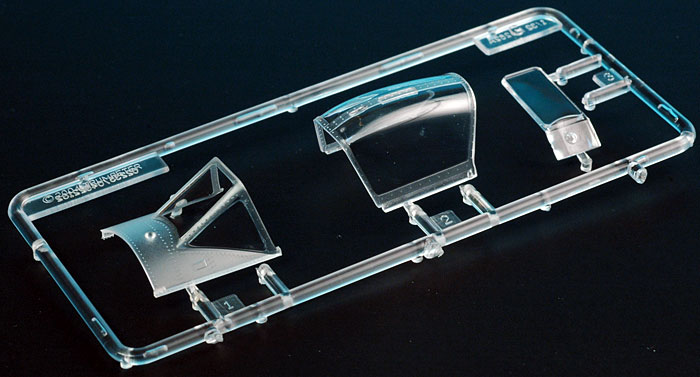
Click the thumbnails below to view
larger images:
The kit features two full Jumo turbojets. One set of sprues
is in grey plastic, and the second is in clear. The Jumos are very well
detailed straight from the box, but the determined superdetailer will
probably add some extra wiring and plumbing if the engines are destined for
display. Strangely, the engine nacelles are not supplied with separate parts
for the forward or lower access panels, so a little careful attention with a
hobby blade will be required if you want to leave the covers off.
Interior detail is very thorough. Not satisfied with
presenting a nicely detailed cockpit and cannon bay, Trumpeter has also
supplied a well-done radio and mount, gyro compass and oxygen bottles for
the inside of the rear fuselage. The radio hatch is separate too, so when
the fuselage halves are joined you will still be able to prove that you have
done all that extra work! Structural detail is also present on the interior
of the fuselage halves, along with a unique insight into the planning of the
kit - raised fuselage station numbers from the masters still visible on the
moulds.
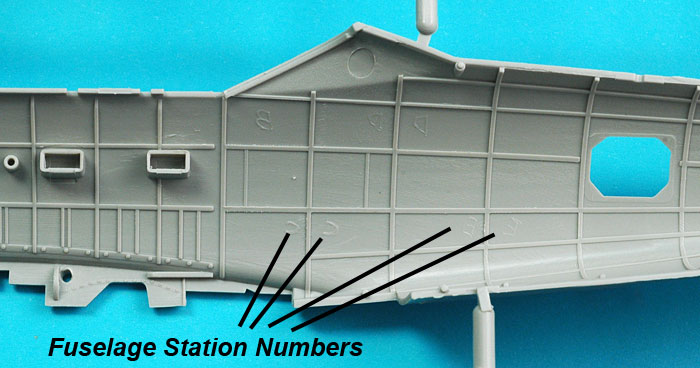
Trumpeter has supplied landing gear legs in both white metal
and plastic, leaving the choice to the modeller. The gear is very simply
broken down. In fact, the forward landing gear is a single part, including
the oleo scissors moulded/cast in place. Note that many Me 262s did not have
the oleo scissors on the forward gear leg. Check your references, but it
will be a simple matter to cut off the scissors if they were not present on
the particular subject you are building.
In common with most of Trumpeter's earlier releases, tyres
are rubber. This will not please some modellers (myself included), but the
seam lines are small and detail is good. We are also offered the choice of
two different nose wheels. Trumpeter's research is more thorough than mine,
in that the two wheels are different widths. I had thought that they were
just different tread patterns.
Multimedia content is further boosted with a set of
photo-etched harnesses. Like the rest of the kit, these parts are well
detailed but should be simple to use, as the buckles and mounts are
integrated with the straps.
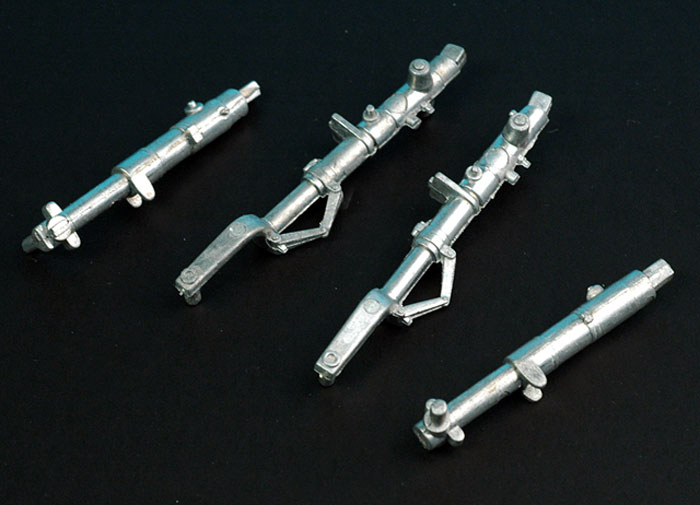
Click the thumbnails below to view
larger images:
Further options include the choice of a two-gun or four-gun
forward cowl, and RATO packs for the bottom of the fuselage.
Nose weight is not supplied but it will certainly be
required. Fortunately there is plenty of room under the forward gun cowl.
Two sets of markings are supplied - red 4 from JG 7 and
Walter Nowotny's White 8.
The profile and dimensions of the kit's main parts compare
closely with scaled-up plans from Eagle Editions' "Stormbird Colors".
In my opinion, this is the finest Messerschmitt Me 262 kit available in
any scale. I also believe that it is clearly Trumpeter's best release to
date.
There are two aspects of this kit that I find especially pleasing, as
they both suggest that Trumpeter is maturing into a quality kit
manufacturer. Firstly, Trumpeter has clearly done their homework before they
started mastering the parts. The kit is well researched and accurate in
outline and, as far as I can tell so far, in detail.
Secondly, it appears that Trumpeter has responded to comments about
earlier releases in terms of surface features (heavy panel lines and deep
rivets), gimmicks such as hinges, and production planning factors including
the location and number of ejector pin marks. This kit is the epitome of
subtle surface detail and sensible parts breakdown.
Trumpeter's offerings have always been ambitious and often impressive due
to sheer size, but their Me 262A-1a seems more thoroughly planned and more
carefully executed than many earlier releases. I get the impression that
someone really wanted to get this one right, and they have. The
modeller has been taken into greater consideration too. This kit is more
simply engineered - for example, plastic tabs versus metal hinges for the
control surfaces - yet still offers plenty of useful detail and options.
Of course, the proof of this pudding will be in the building, but I can't
see too many construction challenges lurking in the sprues, notwithstanding
the high parts count.
Trumpeter's 1/32 scale Messerschmitt Me 262A-1a is a state-of-the-art
model of an important subject. If you are a large-scale aircraft builder or
a Luftwaffe aficionado in general, you are going to love this kit.
Highly Recommended.
Text and Images Copyright © 2005 by
Brett Green
Page Created 31 August, 2005
Last updated 31 August, 2005
Back to HyperScale Main Page
|
Home | What's
New | Features
| Gallery |
Reviews | Reference
| Forum
| Search